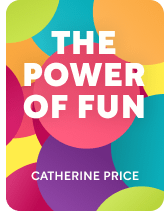

This article is an excerpt from the Shortform book guide to "The Power of Fun" by Catherine Price. Shortform has the world's best summaries and analyses of books you should be reading.
Like this article? Sign up for a free trial here.
Are people just naturally fun or not fun? Are fun people all extroverts? Is it possible to learn how to be a fun person?
The Power of Fun is Catherine Price’s step-by-step guide to inviting more fun into your life. Not only can you have more fun, but you can also be more fun by adopting a certain mindset and creating particular environments.
Keep reading to learn how to be a fun person and bring joy to the world around you.
How to Be a Fun Person
You’ll inevitably have more fun if you become someone who attracts fun to you. For many of us, when someone describes “a fun person,” they picture a person standing on a table in the middle of a party convincing everyone to play charades. But, what if playing charades isn’t your cup of tea? According to Price, not a problem. Price explains that you don’t have to be “the life of the party” or even an extrovert to be considered fun. When asked to describe someone as fun, people describe a person who makes them feel included, laughs easily, and isn’t afraid to try new things or be silly. These are qualities that you can have regardless of where you fall on the introverted/extroverted spectrum. You just need to know how to be a fun person.
(Shortform note: Many people think personality is fixed (for example, you’re either fun or you’re not). But, according to Benjamin Hardy, author of Personality Isn’t Permanent, that’s a myth. Hardy explains that personality is fluid and malleable. To change your personality, he says, you must first decide who you want to be and then choose a single goal to work toward. For example, if you want to become a more fun person, your primary goal could be to try one new thing every week. These incremental steps will lead to long-lasting changes in who you are.)
Price identifies two ways you can become more fun: You can adopt a fun attitude, and you can create a fun environment.
Adopt a Fun Attitude
To adopt a fun attitude, you need to practice noticing or seeking out opportunities for fun, however small. The ability to laugh at yourself, to look for the absurd in the ordinary, to smile more, to be present, and to notice unexpected and delightful moments of pleasure are all examples of ways to hone your fun radar.
(Shortform note: Rubin (The Happiness Project) points out that adopting a more fun-loving and positive attitude won’t just improve your mood but also the moods of the people around you. She explains that your laughter, in particular, goes a long way to making other people happy, which will in turn amplify your happiness, creating a virtuous cycle of joy.)
Create a Fun Environment
You can also facilitate environments that are conducive to fun (what Price refers to as “playgrounds”). Fun environments are spaces where there’s an understanding that the space is meant to be fun, where everyone is 100% in, and where judgment isn’t welcome. Your fun environment might be a dinner club with friends, a virtual Dungeons & Dragons tournament, or an adult kickball league. The activity doesn’t matter, as long as the space invites people to let go and be themselves.
| How to Create a Memorable (and Fun) Experience Even when you intentionally gather people together to have fun, the experience doesn’t always live up to expectations. In The Art of Gathering, Priya Parker outlines five steps you can take before an event to ensure the experience is fun and meaningful for everyone. 1. Identify the reason for gathering and use it as a guideline for decision-making. 2. Curate your guest list to include only those who support the purpose of the gathering. 3. Select an appropriate venue that enhances the guest experience and encourages desired behavior. 4. Create directives or rules for behavior during the event to make diverse gatherings more comfortable and encourage engagement. 5. Set clear expectations with guests before the gathering to help them get into the right mood and prevent disappointment. By putting in the work ahead of time to build an environment with the right crowd and clear expectations, you’re more likely to have fun during the experience itself. |

———End of Preview———
Like what you just read? Read the rest of the world's best book summary and analysis of Catherine Price's "The Power of Fun" at Shortform.
Here's what you'll find in our full The Power of Fun summary:
- Why fun is fundamental to living a happy and healthy life
- How modern society has made it harder to prioritize fun
- A step-by-step guide to invite more fun into your life






